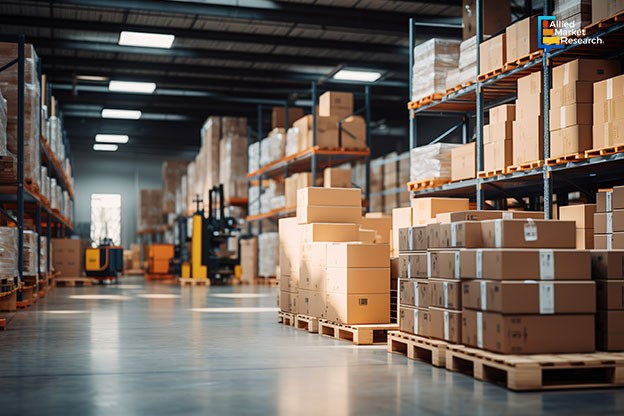Warehousing and Distribution Logistics: Robotics and AI Ushering a New Era in Supply Chain Management

30 Jul
2024
Highlights:
- Introduction
- The role of robotics in the growth of the industry
- Impact of AI and IoT on the warehousing and distribution logistics landscape
In the era of globalization, the volume of trade between different nations has increased significantly, thus making supply chains even more important. A major problem witnessed in developing countries such as India is the high cost of logistics, which is around 16% of the national GDP. Hence, the input costs incurred by companies in exporting their products are much higher, thus making them uncompetitive in international markets. On the other hand, in countries like the US and China, it goes down to just 8% of their national product. To overcome this challenge, governments in emerging economies are actively investing in improving the warehousing and distribution logistics facilities. Even private companies are introducing new technologies to streamline the functioning of these facilities.
Robotics and automation technologies generating new avenues of growth in the landscape
The primary goal of adopting any warehouse technology is to maximize the productivity and operational efficiency of supply chains and logistics facilities. In the recent past, advancements in the fields of electronics, telecommunication, and information technology have led to the emergence of certain innovations which simplify certain functions including, order processing, packing, inventory management, storing, etc. Most of the advanced machines for warehousing and distribution logistics are developed to perform repetitive and cumbersome tasks like opening, delivering, and palletizing product packaging.
For example, in February 2024, OSARO, a robotics company, announced the launch of the Robotic Depalletization System designed specifically for e-commerce warehousing operations. The AI-powered solution has been programmed to perform mixed-case pallet unloading tasks. The advanced detection capabilities and flexible deployment options offered by the system help enhance the productivity of the warehouse.
Along with this, many companies are even employing drones to transport goods inside the warehouse facility. These unmanned aerial vehicles are generally equipped with barcode sensors to scan the inventory and identify the goods to be transported accordingly. Also, these machines have obstacle-sensing systems, smart interfaces, cameras, and onboard processing power to function smoothly and take appropriate actions to complete transportation tasks. Moreover, these UAVs are connected to the warehousing and distribution logistics management system via cloud drive to upload the data that is being collected while working. The overarching framework, thus, conducts warehouse inspections and monitors the changes in inventory in real time.
In February 2024, Anyline, a mobile data capture solutions developer, unveiled an autonomous drone inventory management software. The platform is integrated with a barcode scanning system which has been developed in collaboration with Mondi, a packaging company. Anyline’s CEO, Lukas Kinigadner stated that the product launch is expected to help the company expand its footprint in the warehousing and distribution logistics industry in the coming period.
AI and IoT-powered tools for modern-age warehousing and distribution logistics solutions
During the COVID-19 pandemic, the global supply chains faced massive disruptions due to lockdowns, travel restrictions, and social distancing norms. In the post-pandemic period, several companies and businesses have started adopting technologies such as AI and IoT to make them more resilient. Machine learning tools are gradually being deployed in warehousing operations to identify trends and optimize inventory management. Furthermore, AI also plays an important role in increasing the accuracy of demand forecasting, thereby preventing stockouts and bringing down the costs associated with warehousing and logistics.
A recent study done by the Emylon Business School found that AI algorithms are expected to transform the warehousing and distribution logistics industry by enhancing the safety and well-being of the workers in a warehouse. Moreover, machine learning tools analyze the vast amounts of data collected by robots and drones much quicker than conventional software applications. AI and IoT technologies also aid in transport optimization and route management planning. IoT-powered solutions, by employing sensors and other such advanced electronic devices, collect information regarding the consignment that needs to be transported based on the temperature, humidity, inventory levels, etc. On the basis of this information, artificial intelligence decides the ideal route for the delivery vehicle by taking into account factors like weather forecast, geolocation, and traffic.
To summarize, the introduction of robotics and automation technologies is anticipated to create numerous growth opportunities in the landscape of warehousing and distribution logistics. Additionally, the emergence of AI and IoT-based technologies is predicted to revolutionize the industry by improving workers’ safety and increasing productivity in the long run.
For a detailed analysis of the upcoming trends, advancements, and developments in the sector, feel free to contact us.

Akhilesh Prabhugaonkar
Author's Bio- Akhilesh Prabhugaonkar holds a bachelor’s degree in Electronics Engineering from the reputed Vishwakarma Institute of Technology. He has a special interest in the fields of forensics, world history, international relations and foreign policy, sports, agriculture, astronomy, security, and oceanography. An ardent bibliophile and melophile, Akhilesh loves to write on topics of his interest and various other societal issues. This love for writing made him enter the professional world of content writing and pursue his career in this direction.
Avenue: Entire Library membership of Allied Market Research Reports at your disposal
- Avenue is an innovative subscription-based online report database.
- Avail an online access to the entire library of syndicated reports on more than 2,000 niche industries and company profiles on more than 12,000 firms across 11 domains.
- A cost-effective model tailored for entrepreneurs, investors, and students & researchers at universities.
- Request customizations, suggest new reports, and avail analyst support as per your requirements.
- Get an access to the library of reports at any time from any device and anywhere.
Related Post
-
How are Submarine Cables Transforming Global Connectivity with Enhanced User Experience?
-
Endoscopy Procedures: Transformations in Techniques and Applications
-
AI-Powered Video Analytics: How the Product Actually Works for enterprises
-
Painting Robots: Transforming Precision Coating and Creative Applications
-
Innovations in Pharmacovigilance Systems Advancing Patient Safety
-
Understanding Edge Security: Keeping Data Safe Near the Source
-
Exploring the Use and Advancements of 3D Laser Scanners in Professional Applications
-
Reinforcing Industrial Controls with Smarter Tools and Training








